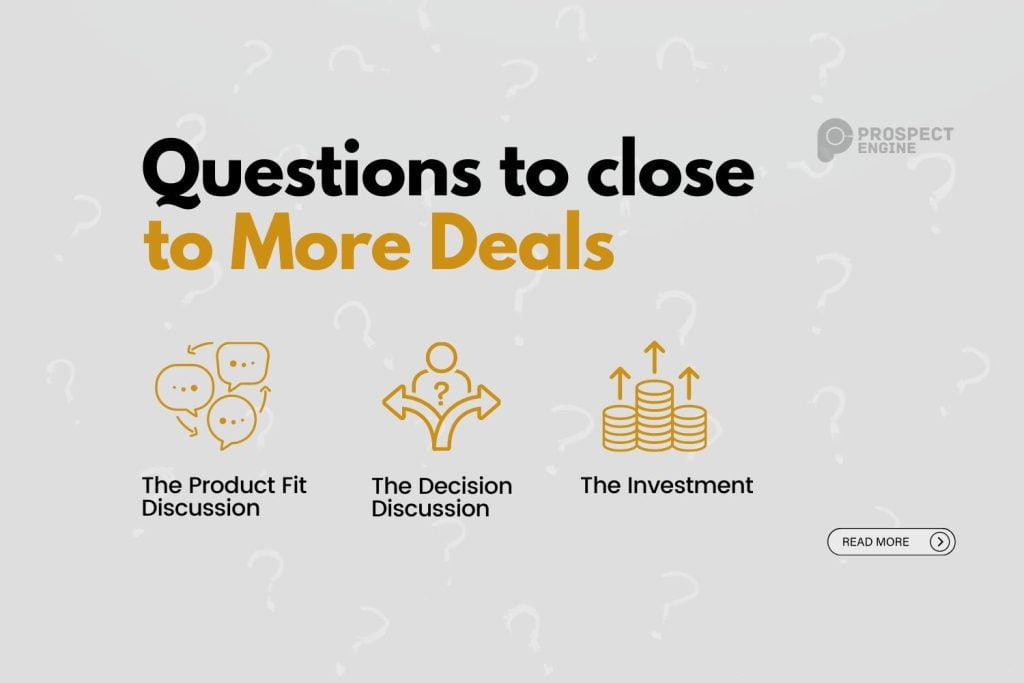A salesperson’s biggest mistake is failing to ask leads enough pertinent questions. Bad salespeople will control the sales discussion by expounding on their firm and all of their product’s qualities. Even good salespeople sometimes avoid investigating thoroughly enough and accepting a potential client’s first response. The sales arc comprises four small discussions that must take place in the correct sequence.
- The Product Fit Discussion
Tick the following boxes:
- You’ve decided that you can assist your prospect in doing something better.
- Your prospect (not you) recognized that your product or service might assist them in achieving their goal. (If not, come to a halt here and find out where the gap is.)
To get support, say something like:
“John, do you believe this will assist you in achieving their intended result?”
Then, as a follow-up, say:
“Why?”
“Why not do it in-house or wait?”
- The Decision Discussion
Next, tick the following boxes:
- Your prospect can make a choice, or you have a direct line of sight to the person who can make a decision.
- Your prospect has agreed to a “decision-making” date and has scheduled the meeting.
- The Investment
Check the following box:
- You’ve made compromises and obtained buy-in from the person with the authority to decide.
- The Process Dialogue
To maximize your chances of closing, you must have your prospect’s agreement on when the contract will be signed. The important term here is “potential buy-in.” When your prospect provides you with a signature date, they’ll want to keep it since individuals want to be consistent with what they’ve stated in the past. (In psychology, this is known as the principle of consistency.)
Here’s how you may approach getting a signature date:
Salesperson: “Tell me about the procedure for making things official.” “Do we simply shake it? “ (Tip: Use comedy to relieve sales pressure.)
Prospect: “First, we need to A, then B, and ultimately C,”
The One Question
Salesperson: “John, presuming you’re OK with the business conditions and sacrifices we’ve made to get the pricing where you need it to be, when can you commit to signing this?”
Prospect: “Sometime in the next three weeks,”
Salesperson: “So that would be… “
Prospect: “November 13th,”
Adding Some Edge to the Signature Date
Put the signing date as a contingency in the contract based on the concessions you made while negotiating to give the date teeth and hasten your transaction via legal/procurement. Have legal draft wording such as “This contract is predicated on obtaining a completely completed agreement by November 13th, 2017.” The inclusion of a signing date in the contract creates a feeling of urgency and prioritizes your agreement above other suppliers. If the date slips a day or two, it’s not a huge concern. However, if it lags too much, you may be able to cancel the contract (since the concessions you made are contingent on the signature date).
Because your prospect (and maybe other organization members) has “buy-in” on earlier talks and have committed significant time, they will be engaged in having the document signed before the deadline. If you must walk away, you likely skipped a step in the prior dialogues. (This is an excellent opportunity for introspection.) However, if a significant amount misses the deadline, tell your prospect that the contract is null and invalid. (With thanks to Mitch Morando for this tip.)
Utilizing this method will have more predictable closing rates and avoid clogging your pipeline with stopped transactions.
Conclusion
It is crucial for businesses to recognize the importance of closing deals and to have effective strategies in place for doing so. The one question that can assist in closing more deals is a powerful tool that can help build trust and rapport with customers and ultimately drive sales.
By framing the question in a compelling and relevant way to the customer’s needs, you can create a sense of urgency and motivate them to take action. The question can be used at various stages of the sales process, including the initial meeting, during negotiations, and at the point of closing the deal.
We strongly encourage you to incorporate this powerful question into your own sales process and see the positive impact it can have on your business. With consistent use and practice, the question can become an integral part of your sales toolkit, helping you to close more deals and achieve greater success. So don’t hesitate to try the question in your own sales process today!





